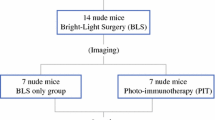Abstract
Photodynamic therapy (PDT) using 5-aminolaevulinic-acid-(ALA)-induced protoporphyrin IX (PPIX) increases survival in hamsters with pancreatic cancer. However, experiments with other photosensitizers on this model show a high risk of duodenal perforation. In this paper, the pharmacokinetics and PDT effects of ALA on normal tissues in the pancreatobiliary region are presented. Using quantitative fluorescence microscopy, maximum PPIX fluorescence was seen in the bile ducts, less in the duodenal mucosa and least in the muscularis propria and pancreas. For PDT, light was delivered either using a bare fibre touching the tissue (single-point illumination), or irradiating a 1.5 cm diameter circular area. Single-point PDT (50 J) produced only localized reversible damage without perforation. Surface irradiation of the whole periampullary region (50 J cm−2) caused extensive damage, sometimes with perforation. Before PDT can be used safely to treat tumours of the pancreas and bile duct, further studies are necessary to understand its effect on larger areas of normal tissue.
Similar content being viewed by others
References
Barr H, Tralau CJ, MacRobert AJ et al. Photodynamic therapy in the normal rat colon with phthalocyanine sensitisation.Br J Cancer 1987,56:111–8
Bown SG. Photodynamic therapy to scientists and clinicians—one world or two?Photochem Photobiol B Biol 1990,6:1–12
Mang TS, Wieman TJ. Photodynamic therapy in the treatment of pancreatic carcinoma: dihematoporphyrin ether uptake and photobleaching kinetics.Photochem Photobiol 1987,46:853–8
Schroder T, Chen IW, Sperling M, Bell RH, Brackett K, Joffe SN. Hematoporphyrin derivative uptake and photodynamic therapy in pancreatic carcinoma.J Surg Oncol 1988,38:4–9
Chatlani PT, Nuutinen PJO, Toda N et al. Selective necrosis in hamster pancreatic tumours using photodynamic therapy with phthalocyanine photosensitisation.Br J Surg 1992,79:786–90
Regula J, Ravi B, Bedwell J, MacRobert AJ, Bown SG. Photodynamic therapy using 5-aminolaevulinic acid for experimental pancreatic cancer—prolonged animal survival.Br J Cancer 1994,70:248–54
McCaughan JS, Mertens BF, Cho C, Barabash RD, Payton HW. Photodynamic therapy to treat tumors of the extrahepatic biliary ducts.Arch Surg 1991,126:111–3
Abulafi AM, Allardice JT, Williams NS, Someren N, Swain CP, Ainley CA. Photodynamic therapy for malignant tumours of the ampulla of Vater.Gut 1995,36:853–6
Mlkvy P, Messman H, Debinski H et al. Photodynamic therapy for polyps in familial adenomatous polyposis—a pilot study.eur J Cancer 1995,31A:1160–5
Evrad S, Aprahamian M, Marescaux J. Intraabdominal photodynamic therapy: from theory to feasibility.Br J Surg 1993,80:298–303
Delaney TF, Sindelar WF, Tochner Z et al. Phase I study of debulking surgery and photodynamic therapy for disseminated intraperitoneal tumours.Int J Radiation Oncology 1993,25:445–57
Allardice JT, Abulafi AM, Grahn MF, Williams NS. Adjuvant intraoperative photodynamic therapy for colorectal carcinoma: a clinical study.Surg Oncol 1994,3:1–10
Bedwell J, MacRobert AJ, Phillips D, Bown SG. Fluorescence distribution and photodynamic effect of ALA-induced PPIX in the DMH rat colonic tumour model.Br J Cancer 1992,65:818–24
Grant WE, Hopper C, MacRobert AJ, Speight PM, Bown SG. Photodynamic therapy of oral cancer: photosensitisation with systemic aminolaevulinic acid.Lancet 1993,342:147–8
Regula J, MacRobert AJ, Gorchein A et al. Photosensitisation and photodynamic therapy of oesophageal, duodenal and colorectal tumours using 5-aminolaevulinic acid induced protoporphyrin IX.Gut 1995,36:67–75
Kennedy JC, Pottier RH. Endogenous protoporphyrin IX, a clinically useful photosensitiser for photodynamic therapy.Photochem Photobiol B Biol 1992,14:275–92
Nuutinen PJO, Chatlani PT, Bedwell J, MacRobert AJ, Phillips D, Bown SG. Distribution and photodynamic effect of disulphonated aluminium phthalocyanine in the pancreas and adjacent tissues in the Syrian golden hamster.Br J Cancer 1991,64:1108–15
Mlkvy P, Messman H, Pauer M et al. Distribution and photodynamic effects of mTHPC in the pancreas and adjacent tissues in the Syrian golden hamster.Br J Cancer 1996 (in press)
Loh CS, MacRobert AJ, Bedwell J, Regula J, Krasner N, Bown SG. Oral versus intravenous administration of 5-aminolaevulinic acid for photodynamic therapy.Br J Cancer 1993,68:41–51
Loh CS, Vernon DI, MacRobert AJ, Bedwell J, Bown SG, Brown SB. Endogenous porphyrin distribution induced by 5 aminolaevulinic acid in the tissue layers of the gastrointestinal tract.Photochem Photobiol B Biol 1993,20:47–54
Dowdle E, Mustard P, Spong N. The metabolism of (5-14C) aminolaevulinic acid in normal and porphyric human subjects.Clin Sci 1968,34:233–40
Ibrahim GW, Watson CJ. Enterohepatic circulation and conversion of protoporphyrin to bile pigment in man.Proc Soc Exp Biol Med 1968,127:890–5
Scott JJ.CIBA Foundation Symposium on The Biosynthesis of Porphyrins and Porphyrin Metabolism. London: Churchill, 1955:43
Matthews EK, Cui ZJ. Photodynamic action of sulphonated aluminium phthalocyanine (SALPC) on AR4-2J cell, a carcinoma cell line of rat exocrine pancreas.Br J Cancer 1990,61:695–701
Moesta KT, Hurley EL, Mang TS. Intercellular organization determines the differential PDT-sensitivities of two human pancreatic cancer lines in vitro. In: Spinelli P, Dal Fante M, Marchesini R (eds)Photodynamic Therapy and Biomedical Lasers. Amsterdam: Excerpta Medica, 1992:292–6
Loh CS, MacRobert AJ, Buonaccorsi G, Krasner N, Bown SG. Mucosal ablation using photodynamic therapy for the treatment of dysplasia: an experimental study in the normal rat stomach.Gut 1996,38:71–8
van Gemert MJC, Cheong WF, Welch AJ, Star WM. Light delivery for whole-bladder photodynamic therapy.Lasers Med Sci 1987,2:273–84
van Staveren HJ, Beek JF, Ramaekers JWH, Keijzer M, Star WM. Integrating sphere effect in whole bladder wall photodynamic therapy: I. 532 nm versus 630 nm optical irradiation.Phys Med Biol 1994,39:947–59
Author information
Authors and Affiliations
Rights and permissions
About this article
Cite this article
Ravi, B., Regula, J., Buonaccorsi, G.A. et al. Sensitization and photodynamic therapy of normal pancreas, duodenum and bile ducts in the hamster using 5-aminolaevulinic acid. Laser Med Sci 11, 11–21 (1996). https://doi.org/10.1007/BF02161288
Received:
Issue Date:
DOI: https://doi.org/10.1007/BF02161288




